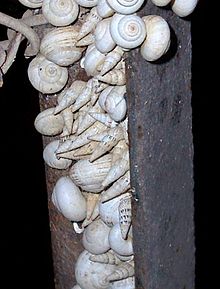- Cochlicella acuta
-
Cochlicella acuta 
Eight shells of Cochlicella acuta from Crete. The scale bar is in millimeters. Scientific classification Kingdom: Animalia Phylum: Mollusca Class: Gastropoda (unranked): clade Heterobranchia
clade Euthyneura
clade Panpulmonata
clade Eupulmonata
clade Stylommatophora
informal group SigmurethraSuperfamily: Helicoidea Family: Cochlicellidae Genus: Cochlicella Species: C. acuta Binomial name Cochlicella acuta
(O. F. Müller, 1774)[1]Cochlicella acuta, common name the pointed snail, is a species of small but very high-spired, air-breathing land snail, a pulmonate gastropod mollusk in the family Cochlicellidae.
Previously however, Cochlicella was placed in the Helicidae or the Hygromiidae instead.
Contents
Distribution
This species is native to parts of Europe. It inhabits south-western Europe including Spain, and western Europe including France, Belgium, Netherlands[2] and the British Isles.[3]
In the British Isles it lives in dunes, sandhills, and grassy downs close to the sea, chiefly in the south and west of England, Wales, on islands off the west coast of Scotland, and along the Irish coast. It is extremely abundant in some areas.[4]
The species has been introduced in the eastern Mediterranean, including Greece[5], Israel and Egypt[6].
It has also been introduced to Australia[7][8], where it has become a problematic invasive, or pest species.[9]
Habitat
 A cluster of Cochlicella acuta (surrounded by larger rounder Theba pisana) aestivating on a fence post in Kadina, Australia.
A cluster of Cochlicella acuta (surrounded by larger rounder Theba pisana) aestivating on a fence post in Kadina, Australia.
This species does well on sandy calcareous soils, and often prefers a coastal setting such as sand dunes. It aestivates by attaching itself to vertical surfaces such as fence posts, tall weeds and so on.
Shell description
The shell of this species is an unusual shape for a helicid, elongatedly conical, 10 to 20 mm high, with a width of only 4 to 7 mm. The spire tapers regularly, but ends in a blunt tip. The oval aperture has a thin lip, and the narrow umbilicus is almost covered.[4]
The shell is very variable in color and markings, often having a cream or off-white background with many pale brown blotches, which are sometimes organized into spiral bands. The shell is often streaked across the whorls with brown. There are sometimes two spiral bands of dark brown or black, which are frequently reduced to only one band, restricted to the body-whorl. Sometimes there are no bands at all.[4]
Ecology
Cochlicella acuta is an intermediate host for the terrestrial trematode parasite Brachylaima cribbi.[10]
See also
References
- ^ Müller O. F. 1774. Vermivm terrestrium et fluviatilium, seu animalium infusoriorum, helminthicorum, et testaceorum, non marinorum, succincta historia. Volumen alterum. pp. I-XXVI [= 1-36], 1-214, [1-10]. Havniæ & Lipsiæ. (Heineck & Faber).
- ^ http://www.anemoon.org/anm/voorlopige-kaarten/kaarten-per-soort/landmollusken/wetenschappelijk/cochlicella-acuta/, accessed 25 September 2008
- ^ Kerney M.P. & Cameron R. A. D., 1979. A field guide to the land snails of Britain and northwestern Europe, Collins, London.
- ^ a b c Step E. 1901. Shell life: an introduction to the British Mollusca. London, New York, F. Warne & co., page 362.
- ^ http://www.firama.com/landsnails2/2455/index.asp
- ^ Commonwealth of Australia. 2002 (April) Citrus Imports from the Arab Republic of Egypt. A Review Under Existing Import Conditions for Citrus from Israel. Agriculture, Fisheries and Forestry, Australia. Caption: Gastropods, page 12 and Appendix 2.
- ^ Cochlicella acuta (Müller) http://www.ento.csiro.au/aicn/name_s/b_1082.htm cited 30 September 2008
- ^ Baker G. H, Hawke B. G. & Vogelzang B. K. 1991. Life history and population dynamics of Cochlicella acuta (Müller) (Gastropoda: Helicidae) in a pasturecereal rotation. J. Moll. Stud., 57, 259-266.
- ^ Charwat S. M. & Davies K. A. 1999. Laboratory screening of nematodes isolated from South Australia for potential as biocontrol agents of helicid snails. Journal of Invertebrate Pathology, ISSN 0022-2011, 74(1): 55-61.
- ^ Butcher A. R. & Grove D. I. 2006. Seasonal variation in rates of sporocyst and metacercarial infection by Brachylaima cribbi in helicid and hygromiid land snails on the Yorke Peninsula, South Australia. - Australian Journal of Zoology, 53(6): 375–382.
Categories:
Wikimedia Foundation. 2010.
